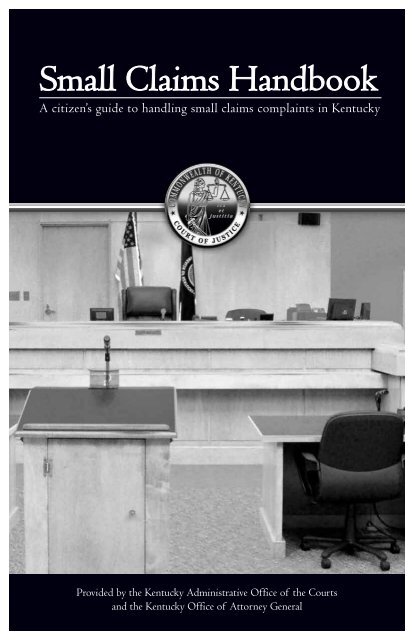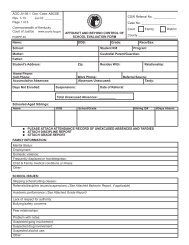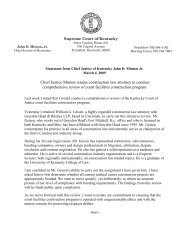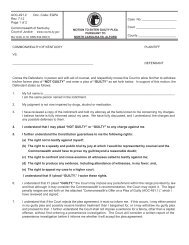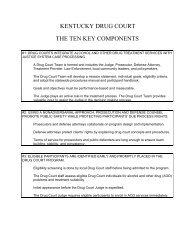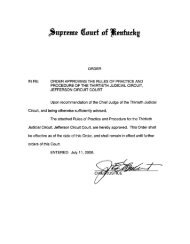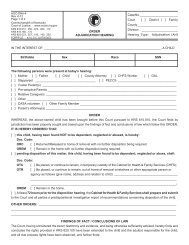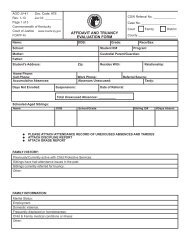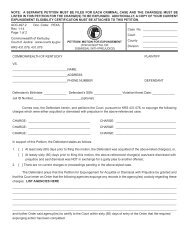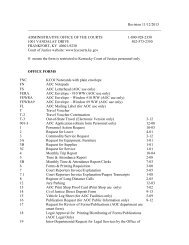Small Claims Handbook - Kentucky Court of Justice
Small Claims Handbook - Kentucky Court of Justice
Small Claims Handbook - Kentucky Court of Justice
Create successful ePaper yourself
Turn your PDF publications into a flip-book with our unique Google optimized e-Paper software.
<strong>Small</strong> <strong>Claims</strong> <strong>Handbook</strong>A citizen’s guide to handling small claims complaints in <strong>Kentucky</strong>Provided by the <strong>Kentucky</strong> Administrative Office <strong>of</strong> the <strong>Court</strong>sand the <strong>Kentucky</strong> Office <strong>of</strong> Attorney General
<strong>Small</strong> <strong>Claims</strong> <strong>Handbook</strong>A citizen’s guide to handling small claims complaints in <strong>Kentucky</strong>Provided by the <strong>Kentucky</strong> Administrative Office <strong>of</strong> the <strong>Court</strong>sand the <strong>Kentucky</strong> Office <strong>of</strong> Attorney General<strong>Handbook</strong> provides guide tosmall claims proceduresEach year thousands <strong>of</strong> cases are decided inthe <strong>Small</strong> <strong>Claims</strong> Division <strong>of</strong> District <strong>Court</strong>,which settles disputes involving money orpersonal property valued at $2,500 or less.The <strong>Small</strong> <strong>Claims</strong> Division allows individualsto save time and money by handling their smallclaims cases in an informal legal forum.The <strong>Kentucky</strong> Administrative Office <strong>of</strong> the <strong>Court</strong>s is pleasedto join the <strong>Kentucky</strong> Office <strong>of</strong> Attorney General to provide thishandbook to those who would like guidance on how to followprocedures for small claims cases. I believe you will find this tobe a valuable resource.John D. Minton Jr.Chief <strong>Justice</strong> <strong>of</strong> <strong>Kentucky</strong>
ContentsOrganizational Chart <strong>of</strong> the <strong>Court</strong>s 1Introduction 2<strong>Small</strong> <strong>Claims</strong> Division 4When to Use the <strong>Small</strong> <strong>Claims</strong> Division 4Statute <strong>of</strong> Limitations 5Who Can File a <strong>Small</strong> <strong>Claims</strong> Suit 6How to File a <strong>Small</strong> <strong>Claims</strong> Suit 7When You are the Plaintiff 7Where to File a Complaint 7Failure to Appear at the <strong>Court</strong> Hearing 9When You are the Defendant 10Appealing a <strong>Small</strong> <strong>Claims</strong> Case 12Filing the Appeal 12Post-Judgment Collections 14Judgment in a <strong>Small</strong> <strong>Claims</strong> Case 14Judgment Not Paid by Due Date 14Identifying the Losing Party’s Assets 14Garnishment 15Execution 18Items Excempt From Execution 19Judgement Lien 20Notice <strong>of</strong> Judgment Lien 20Action to Enforce Judgment Lien 21Difficulty in Collecting Your Judgment 21Satisfaction <strong>of</strong> Judgment 21Appendix <strong>of</strong> Legal Forms 22
<strong>Kentucky</strong> <strong>Court</strong> System<strong>Kentucky</strong> <strong>Court</strong> SystemSupreme <strong>Court</strong>7 <strong>Justice</strong>sJurisdiction:- Direct appeals from Circuit <strong>Court</strong> on judgments <strong>of</strong>death, life imprisonment or imprisonment for 20years or more.- Motions to transfer from <strong>Court</strong> <strong>of</strong> Appeals for causes<strong>of</strong> great and immediate public importance.- Discretionary review <strong>of</strong> <strong>Court</strong> <strong>of</strong> Appeals decisions.<strong>Court</strong> <strong>of</strong>LastResort<strong>Court</strong> <strong>of</strong> Appeals14 JudgesJurisdiction:- Appeals as a matter <strong>of</strong> right from convictions, finaljudgments, orders or decrees <strong>of</strong> the Circuit <strong>Court</strong>,including the Family <strong>Court</strong> Division.IntermediateAppellate<strong>Court</strong>Circuit <strong>Court</strong>57 CircuitsJurisdiction:- All justiciable causes not exclusively vested in some other court.- Civil actions over $5,000.- Felonies or capital <strong>of</strong>fenses.- Dissolution <strong>of</strong> marriage, adoption, termination <strong>of</strong> parental rights(Family <strong>Court</strong>).- Contested will probate.- Appeals on the record from District <strong>Court</strong>.- Jury trials.- Review <strong>of</strong> administrative agency final orders.<strong>Court</strong> <strong>of</strong>GeneralJurisdictionDistrict <strong>Court</strong>60 DistrictsJurisdiction:- Exclusive jurisdiction in civil cases involving $5,000or less, provided the case does not involve equityor title to real estate.- Uncontested probate matters.- Misdemeanors and violations except where thecharge is joined with an indictment for a felony.- Ordinance or code violations and preliminaryhearings.- Juvenile matters, disability determinations,guardianship and conservatorship for disabled persons.- Authority to adjudicate local administrative actionsor decisions.- Jury trials.<strong>Small</strong> <strong>Claims</strong>DivisionJurisdiction:- <strong>Small</strong> claims <strong>of</strong>$2,500 or less,exclusive <strong>of</strong> interestand costs- No Jury<strong>Court</strong> <strong>of</strong>LimitedJurisdiction1
IntroductionThe <strong>Kentucky</strong> Office <strong>of</strong> Attorney General is required to prepare aninformational pamphlet on the <strong>Small</strong> <strong>Claims</strong> Division <strong>of</strong> District<strong>Court</strong>. KRS 24A.350(1). The <strong>Kentucky</strong> Administrative Office <strong>of</strong>the <strong>Court</strong>s is pleased to join the OAG in providing this informationalhandbook on the small claims process.The <strong>Small</strong> <strong>Claims</strong> <strong>Handbook</strong> should:ª ª Help you understand the small claims process.ª ª Provide step-by-step guidance.The <strong>Small</strong> <strong>Claims</strong> <strong>Handbook</strong> will not:± ± Provide legal advice.± ± Make you an authority in small claims or collectionprocedures.± ± Take the place <strong>of</strong> an attorney. If you choose to representyourself, you are expected to do the things an attorney isexpected to do.You should read this entire handbook for information concerningthe rights and duties <strong>of</strong> all individuals involved in the small claimsprocess.How the Office <strong>of</strong> Circuit <strong>Court</strong> Clerk Can HelpThe Office <strong>of</strong> Circuit <strong>Court</strong> Clerk in your county can provide thelegal forms necessary to file a small claims case. However, the circuitcourt clerk is not an attorney and cannot give you legal advice.Some <strong>of</strong> the forms mentioned in this booklet are available on the<strong>Kentucky</strong> <strong>Court</strong> <strong>of</strong> <strong>Justice</strong> Web site at courts.ky.gov/forms/.2
Attorney ReferralIf you need an attorney, the following bar associations canrefer you to an attorney in your area.<strong>Kentucky</strong> Bar Association Lawyer Locator Service502-564-3795 | www.kybar.orgFayette County Bar Association859-225-9897 | www.fcba.comLouisville Bar Association Lawyer Referral Service502-583-1801 | www.loubar.orgNorthern <strong>Kentucky</strong> Bar Association859-781-1300 | www.nkybar.comNotes:3
<strong>Small</strong> <strong>Claims</strong> DivisionThe <strong>Small</strong> <strong>Claims</strong> Division <strong>of</strong> District <strong>Court</strong> in each <strong>Kentucky</strong> county settlesdisputes involving money or personal property valued at $2,500 or less. The$2,500 limit does not include interest and court costs. The jurisdiction for the<strong>Small</strong> <strong>Claims</strong> Division is found in KRS 24A.230.The procedures are informal. You may file a claim or defend yourself without anattorney or you may employ an attorney to handle your case if you wish.In the <strong>Small</strong> <strong>Claims</strong> Division, the parties involved in the dispute go to courtand tell their sides <strong>of</strong> the story to the judge. The judge makes a decision basedupon the law governing the facts presented. There is no jury in the <strong>Small</strong> <strong>Claims</strong>Division.When to Use the <strong>Small</strong> <strong>Claims</strong> DivisionBefore filing a small claims suit, contact the other party and try to settle yourdispute. A settlement out <strong>of</strong> court will save you both time and money. If asettlement is reached, put all <strong>of</strong> the terms <strong>of</strong> your agreement in writing. Signthe agreement and have the other party sign it as well.If you and the other party cannot settle your differences on your own, considerother ways to resolve your dispute. If your dispute is with a <strong>Kentucky</strong>-ownedand operated business or corporation, you may want to contact the ConsumerProtection Division <strong>of</strong> the <strong>Kentucky</strong> Office <strong>of</strong> Attorney General before youpursue a small claims action. However, the Consumer Protection Divisioncannot seek damages and can mediate only between an individual consumer anda business. It does not mediate business-to-business disputes.There are three ways to request a consumer protection complaint form fromthe <strong>Kentucky</strong> Office <strong>of</strong> Attorney General:ffE-mail the Consumer Protection Division atconsumer.protection@ag.ky.gov.ffDownload a form at www.ag.ky.gov/civil/consumerprotection/complaints/forms.htm.4
ffCall 502-696-5389 or 1-888-432-9257 and select option #3. Leaveyour name and address and indicate whether your complaint is againsta telemarketer, automobile dealer or other type <strong>of</strong> business.Only after you are sure that no settlement can be reached should you file a smallclaims action.Before filing suit, you should have some idea <strong>of</strong> whether the person you aresuing has the ability to pay if you win your case. In some cases, a person may be“judgment pro<strong>of</strong> ” because <strong>of</strong> a lack <strong>of</strong> income or property. Therefore, even ifyou win you might not collect your judgment.Statute <strong>of</strong> LimitationsIt is important to file suit immediately after you realize no settlement can bereached. The law sets a period <strong>of</strong> time, called the statute <strong>of</strong> limitations, inwhich a person must file suit. After this period expires, a person cannot file suit.Statutes <strong>of</strong> limitations vary with the type <strong>of</strong> claim. Here are some examples:Oral contracts | <strong>Claims</strong> involving oral contracts have a five-year statute<strong>of</strong> limitations.Written contracts | <strong>Claims</strong> involving written contracts have a 15-yearstatute <strong>of</strong> limitations.Personal injury claims | Some personal injury claims have a one-yearstatute <strong>of</strong> limitations.If you are unsure about bringing your claim within the proper time frame, youmay proceed with filing a suit. However, if too much time has passed the judgewill dismiss the claim and you will lose your filing fee.The Office <strong>of</strong> Circuit <strong>Court</strong> Clerk cannot advise you concerning the statute <strong>of</strong>limitations <strong>of</strong> your claim.5
Who Can File a <strong>Small</strong> <strong>Claims</strong> SuitAny person, business or corporation with a claim for money or personal property<strong>of</strong> $2,500 or less, or who seeks to disaffirm, avoid or rescind a contract oragreement for the purchase <strong>of</strong> goods and services not in excess <strong>of</strong> $2,500, mayfile suit in the <strong>Small</strong> <strong>Claims</strong> Division, except the following:± ± A person or organization in the business <strong>of</strong> lending moneywith interest.± ± A collection agency or a collection agent.± ± A person or organization with an assigned claim (a legal claimor cause <strong>of</strong> action that has been transferred to a third party)or a class action.In <strong>Kentucky</strong>, an individual may not file more than 25 claims in any one calendaryear. A business is entitled to 25 claims for each established location in thedistrict that has been engaged in trade or commerce for at least six months.Limitations on the number <strong>of</strong> claims filed and other requirements <strong>of</strong> thissection do not apply to claims initiated by city, county or urban governments.If a corporation or partnership is a party to a small claims action, the personwho comes to the hearing must be an <strong>of</strong>ficer <strong>of</strong> the corporation, a personregularly employed in a managerial capacity by the corporation or partnership,or an attorney.If you believe you have been wronged, if the claim involves $2,500 or less, andif the exceptions below do not apply, you may sue for actual damages and courtcosts only. The exceptions are:• y Criminal actions• y Cases <strong>of</strong> libel, slander or alienation <strong>of</strong> affection• y Malicious prosecution• y Abuse <strong>of</strong> processThese types <strong>of</strong> actions must be filed in another court.6
In addition, the <strong>Small</strong> <strong>Claims</strong> Division may not be the answer in these situations:• y In a complicated lawsuit, even if the loss is less than $2,500.• y Situations where the other party cannot be located.• y When a person has been wronged by disreputable businesses,companies no longer in business, individuals who have filedbankruptcy or individuals with no money or property.How to File a <strong>Small</strong> <strong>Claims</strong> SuitGenerally there are two parties to a lawsuit:Plaintiff | The person or business filing the lawsuit.Defendant | The person or business being sued.When You are the PlaintiffA small claims lawsuit begins when the plaintiff files a <strong>Small</strong> <strong>Claims</strong> Complaint(form AOC-175) with the Office <strong>of</strong> Circuit <strong>Court</strong> Clerk. The complaintexplains the disagreement.Where to File a ComplaintCircuit court clerks have <strong>of</strong>fices in all 120 <strong>Kentucky</strong> counties and are responsiblefor managing the records <strong>of</strong> Circuit and District courts. Decide in whichcounty to file your complaint and go to the <strong>Small</strong> <strong>Claims</strong> Division <strong>of</strong> theOffice <strong>of</strong> Circuit <strong>Court</strong> Clerk in the courthouse or judicial center in thatcounty. Consider the following when deciding where to file your complaint:Your small claims complaint should be filed in the county where the person youare suing lives or does business, or, in the case <strong>of</strong> corporations, in the countywhere its <strong>of</strong>fice or place <strong>of</strong> business is situated or in which its <strong>of</strong>ficer or agentresides. There are, however, exceptions to this general rule.For example, if you are suing a corporation about a breach <strong>of</strong> contract, thenyou may choose to sue in the county in which the contract was made or was tohave been performed.7
If your complaint concerns a contract but the defendant is not a corporation,then different rules apply and it may be best to file the complaint where thedefendant lives.The maximum amount <strong>of</strong> money for which you can sue is $2,500. Even ifyour claim is for more, you can choose to sue in the <strong>Small</strong> <strong>Claims</strong> Division foronly $2,500 instead <strong>of</strong> filing suit in another division for a greater amount. Theamount <strong>of</strong> your claim should include both the actual amount due and extraexpenses resulting from the unpaid claim. You must be able to prove the amount<strong>of</strong> the claim for which you are suing.To file a small claims action, you will need to complete the <strong>Small</strong> <strong>Claims</strong>Complaint (form AOC-175). You can obtain this form from the Office <strong>of</strong>Circuit <strong>Court</strong> Clerk or you can fill out this form online and print a copy. Theonline form is at courts.ky.gov/forms/formslibrarybycategory.htm under the<strong>Small</strong> <strong>Claims</strong> section.The circuit court clerk is not an attorney and cannot fill out this form for youor provide you with legal advice.You must include the correct address <strong>of</strong> the person you are suing on the <strong>Small</strong><strong>Claims</strong> Complaint form. The Office <strong>of</strong> Circuit <strong>Court</strong> Clerk is not responsiblefor finding an address for you. If you do not have the address, consider lookingin the phone book or consulting other resources.You must also include an explanation <strong>of</strong> your claim against the defendant.Include this information on the complaint form itself and do not attach anexplanation on a separate page.If your suit is against a business, it is your responsibility to determine whoshould be served the summons on behalf <strong>of</strong> the business. You can call the<strong>Kentucky</strong> Office <strong>of</strong> Secretary <strong>of</strong> State at 502-564-3490 or visit www.sos.ky.gov/business/records/ to find out if the business is incorporated and obtainthe name and address <strong>of</strong> the corporation’s process agent. If there are severalparties involved and you cannot determine who to sue, your claim may be toocomplex to be filed as a small claims action. In this case, you should consult aprivate attorney for assistance.8
After completing the complaint form, take it to the Office <strong>of</strong> Circuit <strong>Court</strong>Clerk for filing. You will be charged a fee to file the complaint. The Office<strong>of</strong> Circuit <strong>Court</strong> Clerk will issue a summons to notify the defendant that acomplaint has been filed. The defendant will be sent a copy <strong>of</strong> the complaintand this handbook along with the summons.Tell the circuit court clerk how you want the summons to be served. Youmay choose either certified mail with a return receipt requested or have thesummons personally served on the defendant by the Sheriff ’s Office. The Office<strong>of</strong> Circuit <strong>Court</strong> Clerk requires payment in advance for mailing the summonsby certified mail. If you choose personal delivery, you will pay the service feedirectly to the Sheriff ’s Office.It is your responsibility to check with the Office <strong>of</strong> Circuit <strong>Court</strong> Clerk to besure the defendant has been served the summons. It is not the responsibility <strong>of</strong>the circuit court clerk to notify you. Your case will not be heard by the judgeuntil the defendant has been served the summons. The location, time and place<strong>of</strong> the hearing will be listed on the <strong>Small</strong> <strong>Claims</strong> Summons (form AOC-180).When you present your side <strong>of</strong> the story to the judge, you may also callwitnesses and present evidence to the judge. Each party has the right to examineany evidence presented and may question the other party and witnesses.After hearing both sides <strong>of</strong> the suit, the judge will make a decision based uponthe facts <strong>of</strong> the case and will enter a judgment that will say who won, how muchis to be paid and how it is to be paid.Failure to Appear at the <strong>Court</strong> HearingEven if the defendant does not appear at the hearing, you (the plaintiff) muststill be prepared to show the judge pro<strong>of</strong> <strong>of</strong> your claim.If you (the plaintiff) do not appear for the hearing, the case may be dismissed.The judge may grant any counter-claim filed by the defendant if the defendantcan prove his or her claim.9
When You are the DefendantThe person being sued is the defendant. The defendant will receive a <strong>Small</strong><strong>Claims</strong> Summons with a copy <strong>of</strong> the <strong>Small</strong> <strong>Claims</strong> Complaint and this handbookfrom the Office <strong>of</strong> Circuit <strong>Court</strong> Clerk (if the summons is sent by mail)or the Sheriff ’s Office (if the summons is delivered in person).The complaint will list the name and address <strong>of</strong> the person (the plaintiff) whois suing you, the claim <strong>of</strong> the plaintiff and the amount <strong>of</strong> money or propertyclaimed to be owed by you to the plaintiff. The summons will tell you the date,time and location <strong>of</strong> your court hearing.When you receive a summons notifying you that you have been sued, you mustappear in court on the date stated in the summons. If you do not appear at thetime and place specified on the scheduled date, the judge may enter a defaultjudgment against you for all <strong>of</strong> the money or property claimed by the plaintiff.The judge may further require you to pay all court costs. A judgment is an<strong>of</strong>ficial court order that can be enforced by garnishing your wages and/orseizing and selling your property.Consider the following ways to handle your case:Settle your differences. After you have been sued, you and the plaintiff stillhave an opportunity to settle your differences out <strong>of</strong> court. Consider a compromise.Both time and money may be saved by all parties concerned if you canresolve your case prior to a court hearing. If you want to avoid the court hearing,notify the plaintiff <strong>of</strong> the settlement <strong>of</strong>fer before the hearing.If you and the plaintiff reach a settlement before the hearing, complete a <strong>Small</strong><strong>Claims</strong> Settlement Agreement & Order (form AOC-199). You can obtain thisform from the Office <strong>of</strong> Circuit <strong>Court</strong> Clerk.Both you and the plaintiff must sign the form. Give the <strong>Small</strong> <strong>Claims</strong>Settlement Agreement & Order to the Office <strong>of</strong> Circuit <strong>Court</strong> Clerk for filing.Find out from the circuit court clerk whether you and the plaintiff are stillrequired to appear in court. If the judge approves the settlement agreement, itbecomes legally enforceable.10
Defend your case in court. The hearing is informal. The judge will ask you torespond to the plaintiff ’s complaint against you. Keep your statement as shortas possible without neglecting important facts. Even though you are familiarwith the case, the judge is not. Therefore, it is important to state everythingas clearly as possible and support your statements with evidence. The judge isconcerned only with the facts relevant to the case.When you go to court, take originals (or copies if you do not have originals)<strong>of</strong> contracts, letters, receipts, canceled checks, leases, estimates, police reports,photographs, actual damaged goods or other evidence. The type <strong>of</strong> evidence youneed depends upon your case. You must present evidence to prove every pointin your defense.File a counter-claim. If you believe the plaintiff owes you money or personalproperty related to the same dispute involved in the lawsuit filed against you,you may choose to file a counter-claim.To file a counter-claim, you will need to complete a <strong>Small</strong> <strong>Claims</strong> Counter-Claim(form AOC-185).You can obtain this form from the Office <strong>of</strong>Circuit <strong>Court</strong> Clerk or you can fill out this form online and print a copy. Theonline form is at available at courts.ky.gov/forms/formslibrarybycategory.htmunder the <strong>Small</strong> <strong>Claims</strong> section.Return the completed form to the Office <strong>of</strong> Circuit <strong>Court</strong> Clerk for filing atleast five days before the court date. It is your responsibility to deliver a copy <strong>of</strong>the counter-claim to the plaintiff.There is no filing fee unless the amount <strong>of</strong> your counter-claim exceeds $2,500.If the counter-claim exceeds $2,500, the circuit court clerk will transfer the casefrom the <strong>Small</strong> <strong>Claims</strong> Division to the Civil Division <strong>of</strong> District <strong>Court</strong>. Youwill be charged an additional fee to transfer the case.The procedures in the Civil Division <strong>of</strong> District <strong>Court</strong> are more formal thanin the <strong>Small</strong> <strong>Claims</strong> Division. You may need to hire an attorney to handle yourcounter-claim for you.11
Request a jury trial. You may request a jury trial if your counter-claim exceeds$250. At least seven days before your court date, notify the Office <strong>of</strong> Circuit<strong>Court</strong> Clerk that you want a jury trial. The circuit court clerk will transfer thecase from the <strong>Small</strong> <strong>Claims</strong> Division to the Civil Division <strong>of</strong> District <strong>Court</strong>.You will be charged an additional fee to transfer the case. You may need to hirean attorney to handle the jury trial.Appealing a <strong>Small</strong> <strong>Claims</strong> CaseIf you disagree with the judge’s decision, you may choose to appeal the case.A Notice <strong>of</strong> Appeal must be filed with the Office <strong>of</strong> Circuit <strong>Court</strong> Clerk toappeal the case to Circuit <strong>Court</strong>. A filing fee for the appeal is required.New evidence will not be heard. The Circuit <strong>Court</strong> judge will only review therecord developed in the <strong>Small</strong> <strong>Claims</strong> Division to determine if the law wasapplied correctly. You should not appeal just because you did not win the suit.An appeal is complicated. You may need to seek the advice <strong>of</strong> an attorney tohelp you decide if you have grounds for an appeal. If you lose, you must still paythe original judgment plus any court costs the circuit judge may order. Further,if you hired an attorney to file the appeal for you, you will be responsible forattorney fees.Filing the AppealIf you decide to appeal the judge’s ruling in your case, you must file a Notice<strong>of</strong> Appeal.Deliver the Notice <strong>of</strong> Appeal to the Office <strong>of</strong> Circuit <strong>Court</strong> Clerk for filing inthe <strong>Small</strong> <strong>Claims</strong> Division. This must be done within 10 days from the date thesmall claims judgment was stamped “Entered.”You must file a Statement <strong>of</strong> Appeal in the Circuit <strong>Court</strong> case within 30 days<strong>of</strong> filing your Notice <strong>of</strong> Appeal. It is your responsibility to deliver a copy <strong>of</strong> thesigned Statement <strong>of</strong> Appeal to the opposing party. The Statement <strong>of</strong> Appealmust contain the following information:12
• y The style <strong>of</strong> the case and the District <strong>Court</strong> docket number.• y The name, mailing address and phone number <strong>of</strong> each attorney whomade an appearance in the case, together with the name <strong>of</strong> the partyhe or she represented.• y The name <strong>of</strong> the district judge who presided over the small claims case.• y The date on which the notice <strong>of</strong> appeal and any cross-appeal was filed.• y A statement as to whether the matter has been before the Circuit <strong>Court</strong>on any previous occasion and whether reference to the record <strong>of</strong> theprior appeal is necessary.• y A request for an oral argument if you want the circuit judge to hearyour appeal in person instead <strong>of</strong> you submitting a written argument forthe judge to review. Unless you request an oral argument, the judge willdecide the appeal on the basis <strong>of</strong> the pleadings alone and you will notappear before the judge. You will be notified <strong>of</strong> the time and place toappear if your request for an oral argument is granted.• y A short statement <strong>of</strong> the legal (not factual) issues for consideration bythe judge, including an explanation as to why you believe the districtjudge made an error (or errors) in the small claims judgment. The smallclaims case will not be tried again. The judge will simply review the casefile to determine if the law was applied correctly.• y A fair and accurate summary <strong>of</strong> the evidence heard by the judge in thesmall claims case or a statement that the appeal does not requireconsideration <strong>of</strong> the evidence. New evidence cannot be submitted inyour appeal.• y A statement <strong>of</strong> the relief (compensation) to which you believe you areentitled.You must follow the time limits for filing the Notice <strong>of</strong> Appeal and Statement<strong>of</strong> Appeal. The Notice <strong>of</strong> Appeal and Statement <strong>of</strong> Appeal must be filed withthe Office <strong>of</strong> Circuit <strong>Court</strong> Clerk in the same county where the small claimsaction was filed and heard. There are no forms for the Notice <strong>of</strong> Appeal or theStatement <strong>of</strong> Appeal. You must prepare these documents yourself or you maychoose to hire an attorney to prepare them for you.13
Post-Judgment CollectionsJudgment in a <strong>Small</strong> <strong>Claims</strong> CaseA judgment in a small claims case is a court order that is legally enforceable. Itentitles a winning party to receive money awarded by the court. The judge mayorder the losing party to pay the winning party a sum <strong>of</strong> money or to fix anydamaged goods. The judge may give the losing party additional time to satisfythe judgment.Judgment Not Paid by Due DateIf the losing party fails to pay the judgment ordered by the court within 10 days<strong>of</strong> the due date, additional action may be necessary. First, the winning partyshould contact the losing party and attempt to collect the judgment. This willsave time and money, in addition to avoiding the complexity <strong>of</strong> post-judgmentcollection procedures. If the losing party refuses to pay the amount ordered bythe court, you may wish to take further steps to collect the judgment. Althougha judgment is legally enforceable, you are responsible for taking any additionalaction necessary to collect the money. The Office <strong>of</strong> Circuit <strong>Court</strong> Clerk isprohibited from giving you legal advice.There are three post-judgment collection procedures you may use to collectyour judgment:I. Garnishment <strong>of</strong> the losing party’s wages or bank account(s)II. Execution (seizure) <strong>of</strong> propertyIII. Judgment lienGarnishments, executions and judgment liens can be difficult and hard topursue. You may need to consult an attorney to assist you with these procedures.Identifying the Losing Party’s AssetsIn order to legally enforce the judgment, you must know if the losing partyowns any property, such as land or an automobile, which can be seized, or ifthey have a bank account or salary from an employer that can be garnished. Ifyou do not know this information, you may serve the losing party with writtenquestions (called interrogatories) to find out what you need to know.14
Complete the <strong>Small</strong> <strong>Claims</strong> Post-Judgment Interrogatories (form AOC-197).You can obtain this form from the Office <strong>of</strong> Circuit <strong>Court</strong> Clerk or you canfill out this form online and print a copy. The online form is at courts.ky.gov/forms/formslibrarybycategory.htm under the <strong>Small</strong> <strong>Claims</strong> section.This form contains basic questions to help you obtain information aboutthe losing party’s assets. You may add up to 15 additional questions. Thesequestions are for your use and benefit and are not to be filed with the Office <strong>of</strong>Circuit <strong>Court</strong> Clerk. The circuit court clerk cannot assist you with writing anyadditional questions.Send the <strong>Small</strong> <strong>Claims</strong> Post-Judgment Interrogatories and any additionalquestions to the losing party. Keep a copy for yourself. In order to ensure thatthe losing party receives the interrogatories, you may want to send them bycertified mail. The losing party must answer the questions under oath andreturn a copy <strong>of</strong> the answers to you within 30 days after receiving the questions.If the losing party fails to answer the questions within 30 days, you may file awritten motion requesting the judge to issue an order requiring the losing partyto answer your questions.Complete the <strong>Small</strong> <strong>Claims</strong> Post-Judgment Motion/Order Requiring LosingParty to Answer Interrogatories (form AOC-198). You can obtain this formfrom the Office <strong>of</strong> Circuit <strong>Court</strong> Clerk or you can fill out this form onlineand print a copy. The online form is at courts.ky.gov/forms/formslibrarybycategory.htmunder the <strong>Small</strong> <strong>Claims</strong> section. The circuit court clerk cannot assistyou in preparing the motion.I. GarnishmentThe winning party may use garnishment to obtain money that belongs to thelosing party but is in the hands <strong>of</strong> a third party. There are two types <strong>of</strong> garnishment:15
Wage garnishment | This is money due the losing party as wagesfrom employment, for example. For wage garnishment, the affidavit isthe last page <strong>of</strong> Notice <strong>of</strong> Rights to Assert Exemption to Wage Garnishment(form AOC-150). You must then fill out the remainder <strong>of</strong> the formAOC-150 and select its method <strong>of</strong> service upon the garnishee.Non-wage garnishment | This is money the losing party may havein a bank account, for example. For non-wage garnishment, the affidavitis Affidavit for Writ <strong>of</strong> Non-Wage Garnishment (form AOC-145).You must then fill out an Order <strong>of</strong> Garnishment (Non-Wage) (formAOC-150.1) and choose the method <strong>of</strong> service upon the garnishee. Thegarnishee is any person, corporation or business holding the losing party’smoney. The garnishee may, for instance, be an employer or a bank.In order to get a garnishment issued, follow the court’s order specifying whena garnishment may be issued. If the court’s order does not specify a date whenthe garnishment may be issued, you must wait 10 days from the “Entered” datestamped on the order. To have the garnishment issued, you must file an affidavit.Form AOC-145 may be obtained online, while forms AOC-150 and AOC-150.1 must be obtained from the Office <strong>of</strong> Circuit <strong>Court</strong> Clerk. You may havethe garnishment issued from the Office <strong>of</strong> Circuit <strong>Court</strong> Clerk. There is a feeto have the garnishment issued.You may have the order <strong>of</strong> garnishment served by the sheriff or sent by firstclass or certified mail. The garnishment fee and sheriff ’s fee or mailing costsmay be recoverable as costs and should be added to the amount requested in theaffidavit and order <strong>of</strong> garnishment.The garnishee has 20 days after being served with the garnishment to file ananswer to the garnishment. The garnishee may answer by paying the moneyowed or the losing party may file an Affidavit to Challenge Garnishment (formAOC-150.2) if he or she contests the garnishment.If the garnishee does not answer the garnishment within 20 days, you may file amotion asking the judge to require the garnishee to appear in court. Check withthe Office <strong>of</strong> Circuit <strong>Court</strong> Clerk for a date and time your motion can be heard.The date and time must be included in the motion and a copy must be sent tothe garnishee. There is no form to use in filing this motion. You must prepare ityourself or hire an attorney to file it for you.16
If the judge issues an order for the garnishee to appear in court, you can askthe garnishee why the garnishment was not answered and what assets <strong>of</strong> thelosing party the garnishee holds. If the garnishee fails to appear after beingordered to do so by the judge, you may ask the judge to issue an order forthe garnishee’s arrest.The garnishee is required to pay all <strong>of</strong> the money held for the losing party, upto the amount <strong>of</strong> your judgment, plus costs, except any money the garnisheeproves is exempt from garnishment. An example <strong>of</strong> money exempted fromgarnishment may include money received for support <strong>of</strong> dependent childrenand benefits received by reason <strong>of</strong> age, illness, disability or length <strong>of</strong> service.The garnishee may not be holding enough <strong>of</strong> the losing party’s money to payyour judgment and costs in full. Any money the garnishee is holding will bepaid and applied toward your judgment, with the exception <strong>of</strong> those funds thegarnishee proves are exempt.The order <strong>of</strong> garnishment stays in effect until the judgment is paid in full. Ifyou are not represented by an attorney, the garnishee will forward funds tothe Office <strong>of</strong> Circuit <strong>Court</strong> Clerk. The circuit court clerk is required to holdthe funds for 15 days from the issuance date <strong>of</strong> the garnishment check beforepaying the funds to you. If the debtor files an objection within that period, thecircuit court clerk will continue to hold the funds until the court rules uponthe objection.When your judgment is almost paid in full, obtain the Affidavit and SupplementalOrder <strong>of</strong> Wage Garnishment (form AOC-150.5) from the Office <strong>of</strong>Circuit <strong>Court</strong> Clerk. Complete the form and take it to the Office <strong>of</strong> Circuit<strong>Court</strong> Clerk for filing. You may have the Supplemental Order <strong>of</strong> Wage Garnishmentserved upon the garnishee by the sheriff or you may send it by first classor certified mail. This will let the garnishee know when to stop paying you themoney held for the losing party.If you think the garnishee is withholding money that is due you or if thegarnishee fails to answer to your satisfaction, you may file a separate lawsuit thatwould not be filed in the small claims case. You may want to seek legal advicebefore pursuing this course <strong>of</strong> action.17
Money <strong>of</strong> Losing Party Held in Another County. If you discover money owedto the losing party is being held in a county other than the one in which thejudgment was entered, you may send the order <strong>of</strong> garnishment to the garnisheein the other county. You may have the sheriff <strong>of</strong> that county serve the garnisheeor you may mail the order <strong>of</strong> garnishment to the garnishee by certified mail orfirst class mail. The garnishee will have 20 days to file an answer or to send thefunds to the court where your judgment was entered.How to Garnish Out-<strong>of</strong>-State Wages. If the losing party works for anemployer located outside <strong>of</strong> <strong>Kentucky</strong>, you may garnish wages only if theemployer is subject to process in <strong>Kentucky</strong>. You can call the <strong>Kentucky</strong> Office <strong>of</strong>Secretary <strong>of</strong> State at 502-564-3490 or visit www.sos.ky.gov/business/records/to find out the name and address <strong>of</strong> the employer’s process agent in <strong>Kentucky</strong>.Send the order <strong>of</strong> garnishment to the process agent.No employer may discharge an employee because the employee’s wages aregarnished for any one indebtedness. KRS 427.140.II. ExecutionExecution is a procedure that commands the sheriff to seize property <strong>of</strong> thelosing party. The property can be sold and the money from the sale applied toyour judgment.An execution may be issued 10 days after the date on the “Entered” stamp onthe judgment unless the judge has ordered otherwise. Obtain the Execution(form AOC-135) from the Office <strong>of</strong> Circuit <strong>Court</strong> Clerk. Complete the formand file it with the Office <strong>of</strong> Circuit <strong>Court</strong> Clerk in the county where your judgmentwas obtained. A fee will be charged for issuing the execution.Take the execution to the sheriff who will “execute” it by searching within thecounty for property <strong>of</strong> the losing party.If you know there is no property in the county where the judgment wasobtained, file an affidavit with the Office <strong>of</strong> Circuit <strong>Court</strong> Clerk stating there isinsufficient property in that county and request that an execution be issued forthe county where you think the debtor has property. Send the execution to thesheriff <strong>of</strong> the county where the property is located.18
<strong>Kentucky</strong> law states that the defendant’s personal property is subject toexecution first before any real estate may be seized. KRS 426.230. Personalproperty includes items such as household goods, tools, equipment and automobiles.List both personal property and real estate on the Execution form. Inthe event there is insufficient personal property to satisfy your judgment, thesheriff can execute on the real estate.The sheriff may require you to post a bond to pay for any damages that mightbe incurred in the event the property is proved to have been improperly seized.The sheriff must return the Execution to the court within 60 days <strong>of</strong> issuingthe Execution. (The sheriff ’s return is on the bottom <strong>of</strong> Page 2 <strong>of</strong> the form.) Ifnon-exempt property belonging to the losing party is found by the sheriff, thisinformation will be noted on the sheriff ’s return. The losing party has 10 daysfrom the date <strong>of</strong> service <strong>of</strong> the execution to challenge the execution by filing anAffidavit to Challenge Execution (form AOC-135.1, available online) with theOffice <strong>of</strong> Circuit <strong>Court</strong> Clerk. Any payment made by the debtor to the sheriffwill be applied toward payment <strong>of</strong> your judgment.If the debt still remains, you may need to have the executed property sold inorder to collect your debt. You may obtain an Order for Sale (form AOC-140)from the Office <strong>of</strong> Circuit <strong>Court</strong> Clerk 14 days after the execution is served.Items Exempt From ExecutionSome items are exempt from execution up to a certain value. Example:• y Household furnishings, jewelry, personal clothing and ornaments up to$3,000 in value. KRS 427.010(1).• y Farm tools, equipment and livestock <strong>of</strong> a person engaged in farmingup to $3,000 in value. KRS 427.010(1).• y One automobile and its necessary accessories up to $2,500 in value.KRS 427.010(1); KRS 427.030.• y Pr<strong>of</strong>essionally prescribed health aids for debtor or dependent.KRS 427.010(1).• y Trade tools up to $300 in value. KRS 427.030.• y Pr<strong>of</strong>essional library, <strong>of</strong>fice equipment, instruments and furnishings19


